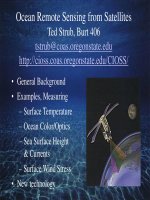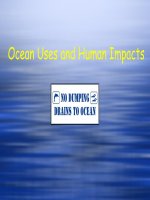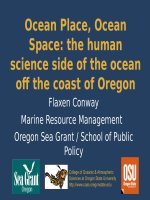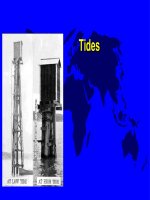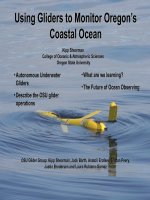oceanography
Bạn đang xem bản rút gọn của tài liệu. Xem và tải ngay bản đầy đủ của tài liệu tại đây (42.03 KB, 6 trang )
The sea is the most obvious feature of the earth's surface.
Approximately seventy percent of this surface is covered by water, in one
way or another. Beneath this water are the familiar sands of the
beaches, bottoms of bays, and the inshore ocean. Farther offshore this
water covers an amazing submarine topography of underwater canyons,
trenches, mountains, and plains. Unlike the continents, which are
physically separated from one another, the oceans are continuous and
interconnected. Since the "world ocean is continuous"(M.J. Keen) it has
similar characteristics throughout. In the early 1870s oceanographers
collected seawater samples from all of the seas of the world at a variety
of depths. When analyzed, the samples were found to have quite similar
characteristics. These findings convinced many that a method of study
was needed. The study of oceans was named oceanography.
Density, salinity, and temperature are very important concepts in the
study of oceanography. The salinity and temperature of the water
influence its density, and the differences in density are the major factor in
understanding the formation of currents and the positions of water
masses in the sea. In addition, temperature and salinity play major roles
in influencing the distribution of plants and animals. The sediments of
the sea floor may be divided into lithogenous, hydrogenous, biogenous,
and cosmogenous sediments. Lithogenous sediments are the major
sediments on the ocean floor. They are derived from the chemical and
mechanical weathering of rocks. Biogenous sediments are composed
primarily of the protective outter covering of small marine animals and
plants. If these remains comprise at least thirty percent of the sediment it
is called an "ooze". "Oozes" were named for the types of organisms that
formed them. Hydrogenous sediments form as a result of the chemical
reactions that occur in the seawater. These reactions result in the
formation of small particles, which are deposited on the sea floor.
Currents move these particles and cause them to collide with the other
particles. If many of these collisions occur they may form nodules.
Nodules are found on some portions of the deep-sea floor. The sediment
type frequently determines the type of organisms that will be found in that
specific area. "Waves are variable and transitory features of the
sea's surface." (Sandra Smith) All waves, from the smallest ripple to the
most destructive tsunami, have common characteristics. They all have
crests, troughs, wave heights, lengths, and periods. Also, water particles
that make up the waves all move in identical orbital patterns. The orbital
pattern is up and forward in the crest and down and back in the trough. It
is only when the wave becomes unstable that the orbital motion is
destroyed. The water particles then begin to move at the same speed as
the moving wave form. Breaking waves release a tremendous amount
of stored energy on a beach face. This energy moves the sand about
and changes the configuration of the bottom. As the bottom configuration
is changed by the waves, it changes the characteristics of incoming
waves. This interaction between the waves and the bottom results in the
beach face having an everlasting wave pattern. Everything in the
universe is composed of extremely small paritcles called atoms, which
are often bonded together to form molecules. Molecules are formed as
the result fo the transfer of electrons between atoms. The complete loss
and gain of electrons results in the formation of ionic molecules, which
have completely positive and negative vegions. Unequal sharing of
electrons, on the other hand, characterizes the polar covalent molecules,
which have only partially positive and negative regions. The equal
sharing of electrons result in the formation of nonpolar covalent
molecules, which do not develop charged regions. Due to the
development of charges on ionic and polar molecules, intermolecular
attractive forces form between these molecules, intermolecular attractive
forces form between these molecules and enable the compounds to exist
in the solid and liquid state. Ionic compounds have long-range order and
exist as solids. Polar covalent molecules are liquids because of their
short-range order, while the nonpolar gases do not develop
intermolecular attractions and as a result exibit no order. Changes in
state are due to a change in the order of compounds. When energy is
added, molecular motion increases and intermolecular attractive forces
are disrupted. This results in the melting of solidsand the evaporation of
liquids. When energy is removed, the molecular motion is decreased,
which increases the formation of intermolecular attractive forces. This
allows vapors to condense as liquids to freeze. The physical and
chemical components of water interact with and affect the plant and
animal life in the sea. The plants, animals, and bacteria that inhabit a
given marine area continually react with, change, and are changed by the
total biotic and abiotic environment. Light plays a vital role in the sea,
since the producers require sunlight as the energy source to convert the
low-energy simple plant nutrients into the more complex high-energy
molecules that can be used by the consumers. The dominant plants of
the sea are the microscopic phytoplankton, while copepods. The
copepods are important, since they provide the major link in the transfer
of energy from the phytoplankton to the large animals of the sea.
Density exerts profound effects on both the biotic and abiotic components
of the sea. Many marine forms, both animal and plant, have developed
unique life-styles of seawater. In addition, density barriers are formed in
the sea in response to temperature and salinity differences between
water masses. In many cases these density barriers trap nutrients below
the euphotic zone and make them spatially unavailable to the plants in
these areas. This is the case in the tropical seas, as well as in all of the
world's deep oceans, where the density barriers are permanent. Plant
nutrients tend to cycle throughout marine systems, from their simple,
low-energy, dissolved forms to plants, animals, and then to bacteria.
When considering the cycling of nutrients through any system, it is
important to remember that metter and energy are inter-changeable.
Cycles that encompass both the biotic and abiotic components of a
system are called biogeochemical cycles. Biochemical cycles
involve the transfer of the essential, minor, and trace elements from the
abiotic to the biotic components of a system. The transfer of food is
extremely important in marine life. The transfer of food energy may be
depicted by food chains and food webs. Food chains can be and
generally are unstable, since the loss of a single link can have drastic
effects on the remainder of the chain. Food webs are more stable, since
a variety of alternate food sources exist at each trophic level.Wind-drift
currents are formed by wind moving across the surface of the sea and
setting water in motion. Winds are formed by the warning and cooling
affects the density of the air, causing it to move into adjacent air masses.
Once in motion, both air and water masses are influenced by the rotation
of the earth. This causes the water masses to appear to deflect to their
right in the Northern Hemisphere and to their left in the Southern
Hemisphere. As a result, the major wind currents appear to travel in large
figure eights from the equator northward and southward. Density
currents involve a large percent of the sea's volume. Since these
currents are the result of temperature and salinity differentials that
develop between adjacent water masses, they are often called
thermohaline currents. The thermohaline circulation travels through
the subsurface waters of all of the world's oceans. These currents carry
oxygen to the a ysphotic zone, where because of the absence of light,
photosynthesis can not occur. They also remove large amounts of
nutrients from the euphotic zone and transport them for great distances
throughout the deep ocean. The current patterns in estuaries are
also generally formed in response to density differentials. Depending on
the amount of marine and fresh water that enters these systems,
estuaries may be highly or moderately stratified, vertically homogeneous,
or hepersaline. The resultant salinity variations in these areas has a
direct influence on the biotic distributions in estuaries. Shorelines are the
point of contact between the marine and terrestrial environments and, as
such, are flooded at high tide and exposed at low tide. They are only a
part of the coastline or coastal zone, inland and for hundreds of miles
along a shoreline. Shorelines are constantly changing. Coastal
sediments are continually attacked and reworked by the sea. Waves
move these sediments into the surf zone, where they are picked up and
transported by the the long-shore current. Those sediments are sorted
by this currentand eventually deposited to form such major coastal
features as barrier islands and sand splits. Inlets form, migrate, close,
and reform along barrier beaches. A combination of inlet fromation,
closure, and the overwash of a barrier beach during storms causes the
barrier island to migrate towards land. Estuaries are also major coastal
features. They form in a variety of ways. They may form behind a barrier
island, sand spit, sea island, or other such feature or be formed by the
tectonic movements of isostatic adjustments of the earth's crust. Others
are formed directly by glacial activity. Estuaries are called a variety of
names, including bays, sounds, and lagoons. These are the most
common, but regardless they are all semi-enclosed bodies of water with
one or more free connections with the sea. The construction of
groins, jetties and breakwaters is often harmful and tend to cause of
increase erosion. All coastlines are extremely dynamic areas that are
interrelated by the longshore currnet. Although these areas must be
treated as units, since what occurs along the way will be reflected by
beach conditions down the current. The coastal zone provides an
unrivaled opportunity to observe ecological relationships. The sea,
offshore the inner neritic zone, is remarkable in its constancy. In any
given area, the salinity and temperature are virtually invariable. Pressure
is constant, but no other environment are the organisms sujected to such
tremendous pressures. The vast majority of the palagic and benthic
realms are in perpetual darkness, and effective photosynthesis does not
occur. All the organisms of the open ocean are then dependent on the
small portion of the sea that is in the euphotic zone. As a consequence,
the animal life is sparce, and different food chains develop. In the deep
ocean much of the initial energy is thought to be provided by the bacteria,
which like the phytoplankton of the euphotic zone, serves as a food
source for the grazers. The second law of thermodynamics, in
conjunction with the small area that is actuall inhabited by the producers,
shows the fallacy of relying on the sea as a food supply. It this becomes
a reality due to over-population, it will be necessary to feed at a trophic
level much closer to the energy source. Coral reefs are one of the most
beautiful and exciting phenomena in the oceans. The coral reef is a
biological community consisting of the coral itself and a variey of small
animals and plants, of which algae is as abundant as the coral. The
framework, or base, of the reef is formed by the skeleton of dead coral
animals, with the living corals and algae at the top of the reef. As the
kinds of reef that grow at sea level have to be solid enough to withstand
the battering of the waves, framework must be strong. Many fish and
other animals and plants live on or in reefs, and all this life forms a rich,
varied and colorful community. Coral reefs occur in warm, tropical
oceans where the temperature is higher than sixty-eight degrees
farenhiet. They need sunlight in order to grow, so they only grow in clear
shallow water down to depths of not much more than a hundred feet.
Reefs also need a good circulation of sea water to bring them oxygen and
food, so strong wave action is beneficial to them. Coral is an animal
which reproduces very quickly by splitting, to form colonies of coral. Each
animal has a chalky skeleton which is joined to neighboring skeletons,
forming the strong framework of the reef. In some coral colonies, such as
brain coral, it is impossible to see each individual animal; but in other
colonies, the skeleton of each animal can be seen. Coral feed on
zooplankton. However, the microscopic plants that live within the coral
also supply it with food and reef-building materials. The plant in return
seemed to benefit from the coral, gaining shelter and food materials from
it. There are three main types of coral reefs: the fringing reef, the
barrier reef, and the atoll. Conditions on reefs vary from the breaking surf
of the sea edge to the quieter lagoon. The fringing reef grows out from an
island, or other land form, but is still attached to it. An example of fringing
reefs are the reefs bordering the Florida Keys. A barrier reef is separated
from the island or mainland, and may be a few miles distant. The Great
Barrier reef is over a thousand miles long, forming an off-shore
break-water for the east coast of Australia. An atoll is a circular
surrounding a lagoon, often not associated with any obvious land. Atolls
occur mainly in the Pacific and Indian Oceans, rising abruptly from the
deep seas. A few centuries ago scientist were puzzled to find coral
atolls in the deep oceans with no land visible because they knew that the
corals could only grow in shallow. The naturalist Charles Darwin during
his voyage on HMS Begal from 1831 to 1836, examined the number of
atolls and put forth a theory for their formation. He suggested that a
volcanic or seamount provided a shallow water base for the growth of the
fringing reef. This island would be eroded by the waves and would sink
slowly under its own weight. To remain in shallow water, the corals of the
reef would grow upward as the island sank until the reef became
separated from the island by a donut-shaped lagoon, forming a kind of
barrier reef. Further sinking of the island below the sea surface would
leave only the reef as an atoll, the island being no longer visible.
Darwin's theory was not proven correct until 1952, when holes were
drilled into Eniwetok Atoll in the Pacific Ocean. After drilling through
almost a mile of coral, the scientist reached the old volcano. It had been
sinking for some 60 million years and all this time the coral had been
growing upward keeping pace with the sinking island. The
reproduction of coral is very interesting. During the reproduction stage of
the coral, the animal itself is stationed. First and foremost, the part of the
coral that is actually doing the reproducting is called the polyp. Polyps
reproduce in two different ways. One is by eggs, and the other is by a
process called budding. When the egg is fertilezed by sperm, the egg
develops into a tiny larcal organism called a planulae. The planulae
settles on the ocean bottom. The planule lands on whatever the currents
allow it to. It will most likely end up on a rock, or on another coral.
Eventually the planulae develops into a polyp. Each polyp builds a
limestone skeleton which is attached to the surface of which the poyp has
landed on, which can be either a rock or another coral. After the coral
establishes itself, the upper part of the body becomes dome-shapes and
develops a stomach and a mouth. Tentacles form around the
mouth. The tentacles are used to draw food in from the surrounding
waters of the oceans. the tentacles of teh coral are armed with special
stinging structures. Those special stinging structures are called
nematosysts. The tentacle's nematocysts paralyzes th etiny prey that the
coral eats. The coral's major food are small marine organisms. In
recent years, outbreaks of cholera, typhoid, and viral hepatitis in Latin
America, the Mediterranean and Southeast Asia have all been traced to
contaminated seafood. It is because of the discharge of sewage and
polution directly into coastal waters. Industrial wastes have been dumped
in the oceans of our world. They contain a mixture of chemicals, such
lubricating oils, zinc, copper, bleaching agents, and strong acids & alkalis.
These chemicals are extremely toxic to marine organisms. There is
strong need for international action to control marine contamination and
pollution. Pollution is now the subject of numerous regional and
international agreements. Conventions regulating the discarge of oil from
ships, and the development of emergency response systems to oil
pollution accidents have contributed to the decline of ship-based souces
of oil pollution over the last two decades. The moratorium on dumping of
radioactive waste at sea under the London Dumping Convention also
represents another response to concerns about the risks posed by such
diposal. Some regions have concluded agreement which ban dumping of
any radioactive waste at sea. In the Mediterranean and Red Sea, all
discharge of oily wasted from ships is also banned. The differences
between terrestial regions are well known. Less well known are the
features that distingush the Atlantic from the Pacific Ocean, or the coast
of South America from those of Southern Africa. Regardless of this, the
various regions of the world's oceans are all affected by human activity,
with pollution and harvesting of resouces of resouces being common to
all seas and oceans. The various marine resources, as well as the extent
of human impacts on them, are examined region by region, illustrating
hos stresses on the marine environmet treatened the very resistance of
some habitats and species.

